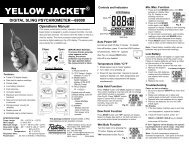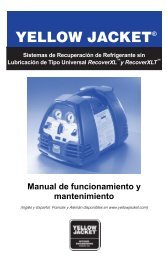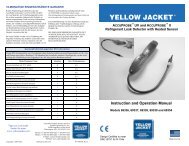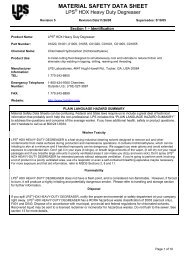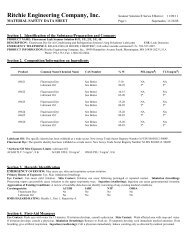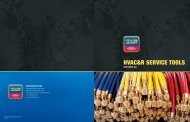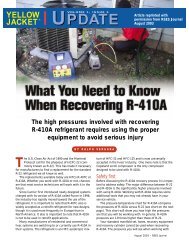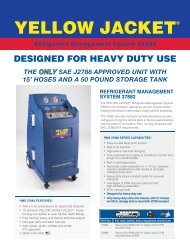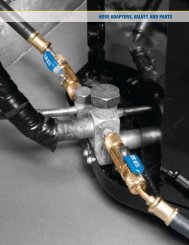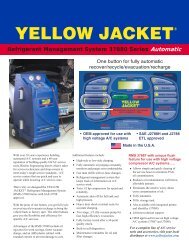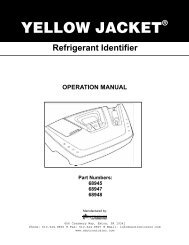YELLOW JACKET High Vacuum Pump Oil 1 - HVAC-Talk
YELLOW JACKET High Vacuum Pump Oil 1 - HVAC-Talk
YELLOW JACKET High Vacuum Pump Oil 1 - HVAC-Talk
Create successful ePaper yourself
Turn your PDF publications into a flip-book with our unique Google optimized e-Paper software.
<strong>YELLOW</strong> <strong>JACKET</strong>® <strong>High</strong> <strong>Vacuum</strong> <strong>Pump</strong> <strong>Oil</strong><br />
SECTION 12. ECOLOGICAL INFORMATION<br />
Ecotoxicity<br />
Environmental Fate<br />
Analysis for ecological effects has not been conducted on this product. However, if spilled,<br />
this product and any contaminated soil or water may be harmful to human, animal, and<br />
aquatic life. Also, the coating action associated with petroleum and petroleum products can<br />
be harmful or fatal to aquatic life and waterfowl.<br />
Biodegradability: Inherently biodegradable in aerobic conditions.<br />
Partition Coefficient (log Kow): >6 (based on similar materials)<br />
Photodegradation: Based on similar materials, this product will have little or no tendency to<br />
partition to air. Hydrocarbons from this product which do partition to air are expected to<br />
rapidly photodegrade.<br />
Stability in Water: Not readily susceptible to hydrolysis under aquatic conditions.<br />
Distribution: Principally to soil and sediment. Petroleum-based (mineral) lubricating oils<br />
normally will float on water. In stagnant or slow-flowing waterways, an oil layer can cover a<br />
large surface area. As a result, this oil layer might limit or eliminate natural atmospheric<br />
oxygen transport into the water. With time, if not removed, oxygen depletion in the waterway<br />
may be sufficient to cause a fish kill or create an anaerobic environment.<br />
SECTION 13. DISPOSAL CONSIDERATIONS<br />
Hazard characteristic and regulatory waste stream classification can change with product use. Accordingly, it is<br />
the responsibility of the user to determine the proper storage, transportation, treatment and/or disposal<br />
methodologies for spent materials and residues at the time of disposition.<br />
Conditions of use may cause this material to become a "hazardous waste", as defined by<br />
federal or state regulations. It is the responsibility of the user to determine if the material is a<br />
"hazardous waste" at the time of disposal. Transportation, treatment, storage, and disposal<br />
of waste material must be conducted in accordance with RCRA regulations (see 40 CFR 260<br />
through 40 CFR 271). State and/or local regulations may be more restrictive. Contact your<br />
regional US EPA office for guidance concerning case specific disposal issues. Empty drums<br />
and pails retain residue. DO NOT pressurize, cut, weld, braze, solder, drill, grind, or expose<br />
this product's empty container to heat, flame, or other ignition sources. DO NOT attempt to<br />
clean it. Empty drums and pails should be drained completely, properly bunged or sealed,<br />
and promptly sent to a reconditioner.<br />
SECTION 14. TRANSPORT INFORMATION<br />
The shipping description below may not represent requirements for all modes of transportation, shipping<br />
methods or locations outside of the United States.<br />
US DOT Status Not regulated by the U.S. Department of Transportation as a hazardous material.<br />
Proper Shipping Name Not regulated.<br />
Hazard Class<br />
Reportable Quantity<br />
Placard(s)<br />
Not regulated.<br />
Packing Group<br />
UN/NA Number<br />
A Reportable Quantity (RQ) has not been established for this material.<br />
Not applicable.<br />
Not regulated.<br />
MSDS No. 634104001<br />
Revision Date 8/24/2009<br />
Continued on Next Page Page Number: 6



